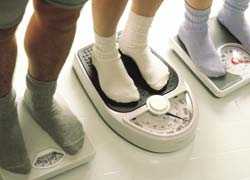Obesity
- Children Eating More Fruit Not More Vegetables
The amount of whole fruit children, 2-18 years old, ate increased by 67% from 2003 to 2010 and replaced fruit juice as the main contributor of fruit to children's diets. Experts recommend that most fruit come from whole fruit, rather than juice. The amount of vegetables children ate did not change from 2003 to 2010. Child care, schools, and school districts can support efforts to increase fruit and vegetable consumption in children.
8/12/2014 1:00:00 PM - Progress on Childhood Obesity
Obese children are more likely to become obese adults and suffer lifelong physical and mental health problems. Obesity rates in low-income preschoolers, after decades of rising, began to level off from 2003 through 2008 and now are showing small declines in many states.
8/6/2013 1:00:00 PM - More People Walk to Better Health
More than 145 million adults now include walking as part of a physically active lifestyle. More than 6 in 10 people walk for transportation or for fun, relaxation, or exercise, or for activities such as walking the dog. The percentage of people who report walking at least once for 10 minutes or more in the previous week rose from 56% (2005) to 62% (2010).
8/7/2012 1:00:00 PM - Hospital Support for Breastfeeding
Childhood obesity is an epidemic. In the US, 1 preschooler in 5 is at least overweight, and half of these are obese. Breastfeeding helps protect against childhood obesity. A baby's risk of becoming an overweight child goes down with each month of breastfeeding.
8/4/2011 1:00:00 PM - Adult Obesity (PDF)
Obesity is common, serious, and costly. In 2009, about 2.4 million more adults were obese than in 2007.
8/3/2010 1:00:00 PM
- Page last reviewed: October 6, 2015
- Page last updated: October 6, 2015
- Content source:
- Office of the Associate Director for Communications (OADC)
- Page maintained by: Office of the Associate Director for Communications (OADC)


 ShareCompartir
ShareCompartir




